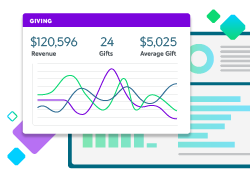Building the Business Case and Proving the ROI of Your Extensibility Project

Everywhere we turn, we hear talk of automation. Large and small nonprofits are finding ways to automate repetitive tasks, reach out to supporters in new, more personalized ways, and connect applications that don’t usually connect. Automations are becoming so essential, in fact, Gartner estimates that by 2025, 70% of new applications developed by enterprises will be based on low-code or no-code tools (in 2020, it was less than 25%).
If your nonprofit is considering a custom automation, but you assume such a project requires either a massive budget or coding expertise (or both), you will be pleasantly surprised to discover that new low-code/no-code solutions exist now to enable “citizen developers” (you and me!) to teach our computers to do our work for us. And the best part? You don’t need to know a single programming language.
There are so many benefits to automation and extensibility projects:
- Offloading time spent on repetitive tasks to free up employees so they can focus on more strategic assignments
- Eliminating human error from data entry
- Improving response times
- And the list goes on …
But what is the cost involved? Training? Time for staff to learn new software? Hiring a contractor? How can you justify the expense?
You need to be able to clearly articulate the need for automation and new low-code/no-code platforms, identify the expenses involved, and define the returns you and your organization can expect to see.
Automation Changes the Game for Nonprofits
We work with a nonprofit organization that noticed small gifts from major donors slipping through the cracks. Gift officers did not check for gifts from their assigned donors each day. As a result, they missed opportunities to reach out and connect with these potentially valuable donors as they gave non-major gifts. So, we created an automation that accomplishes the following tasks:
- Looks for gifts from assigned donors
- Sends an email notification to the fundraiser
- Creates an action record for follow-up
This automation saves gift officers time each day since they no longer have to comb through lists of gifts. And it saves the database manager time in creating reports.
In fact, because of our automation, a development team member at the nonprofit was prompted to make a thank-you call to a donor for a small gift. She ended up building a relationship with that donor, learned about his interests, and he has now committed to a $40,000 annual renewing gift.
In another organization we work with, acknowledgment letters are sent in English to most donors, but also in Spanish to donors who have asked for communications in Spanish. It was a constant struggle to get the language information from the constituent record to the gift record. The workaround the team came up with took a lot of staff time and was inefficient and inconsistent.
The solution? Automation. Each night, an automated flow looks for new gifts, evaluates the language preference of the donor, and adds a gift attribute indicating the language to be used for the acknowledgment letter. This automation makes it easy to add language information to the gift acknowledgment process, saving the staff time, headaches, and errors.
What else can you accomplish with automation? The sky’s the limit, and nonprofits like yours automate a range of redundant tasks such as birthday notifications and volunteer sign-up forms, as well as workflows connecting their CRM to their financial management platform.
Estimating the ROI of Extensibility Projects
We all have long lists of fundraising and operational processes that could be improved by automation, but how do you know when it’s worth it to take the time and resources to explore an automation solution? And how do you convince your organization to invest? You can answer these questions by building a thoughtful and well-researched business case for your first (or next) extensibility project.
4 Steps to Building Your Business Case
1. Start by listing specific tasks you believe you could automate. Ask yourself and your team:
- What are the problems we could solve?
- Where could time be saved?
- What extra services could we provide if these solutions were automated?
In our first example, the gift processing staff didn’t have the bandwidth to provide personalized notifications for each gift officer. With this task automated, gift officers have quick access to helpful information automatically.
In our second example, the staff member responsible for acknowledgments spent 5-10 minutes every day ensuring that the language of each letter was correct. She has that much time back each day to spend on other work.
While this seems like small increments of time saved, take a moment to calculate the larger impact. How much time is saved each week, month, and year? Saving yourself 10 minutes each day adds up to a total of more than 40 hours per year, a full work week. With a few hours of focused attention to build an automation, you can save your organization an additional week to work on more strategic tasks.
2. Once you have your wish list, do your research on the solutions. A good place to dive in is our forum discussion: Power Automate—Where Do I Start? Then, identify the estimated cost to start (it’s low) and explore the resources that can help you launch a project:
- Certified templates are built by experts right inside Power Automate; just a few clicks will get these set up and ready to go
- Template showcase provides automated workflows designed by other users, which you can import into your Power Automate and customize for your needs
- Tutorials offer on-demand training videos to teach you how to use the connectors in Power Automate
Using these tools, it is completely realistic for you to get some simple automations up and running in a matter of minutes. Getting your feet wet also will give you an idea of how much time and energy it will take to build a customized solution for your business problem.
3. Consider who will do the work and what members of the team are involved. IT, development, gift processing, and finance will all have different pieces of the puzzle and may need to be part of the decisions. Pro tip: Look for solutions that will save time and headaches for more than one department.
4. With all the information gathered, clearly outline a few projects you would like to tackle. Choose projects that will have the greatest impact on your organization. Enumerate the benefits and costs and the anticipated return on investment including:
- Increased/enhanced services
- Time savings
- Cost in dollars and time to build and deploy custom automations
When building your business case, be sure to mention that the projects you are planning are just scratching the surface of what’s possible with low-code/no-code platforms. If you and your organization invest your time in automation, you will find more and more ways to use these tools to save staff time and effort and improve your services. You can automate stewardship emails to donors, data clean-up, and notifications of every kind.
Time spent learning to automate your work will come back to you exponentially. When coauthor Austen spent 35 hours learning to connect Power Automate and a donor-fundraising platform, not only did she save her previous organization more than 100 hours per year, she solved a problem they previously thought would never be solved based on available staff time.
Taking Automation to the Next Level
If you’re interested in learning more, get involved by joining the Microsoft Integrations Forum. It is filled with citizen developers at all levels of expertise enhancing their work by using Microsoft Power Platform and their existing donor and fundraising-management software platform. It’s a great place to get ideas, learn from others, and troubleshoot problems for your nonprofit.
The Nonprofit CRM Built for Fundraisers
Find out how Blackbaud’s Raiser’s Edge NXT® fits your organization.


